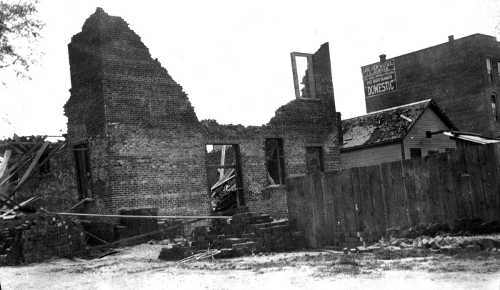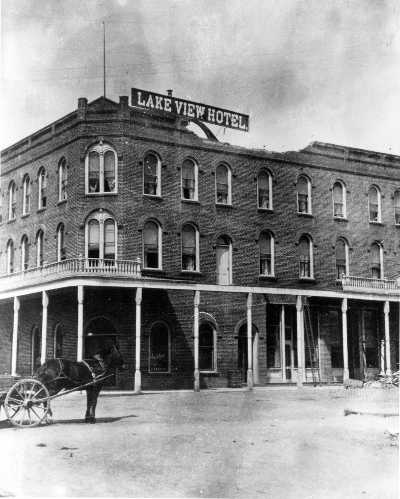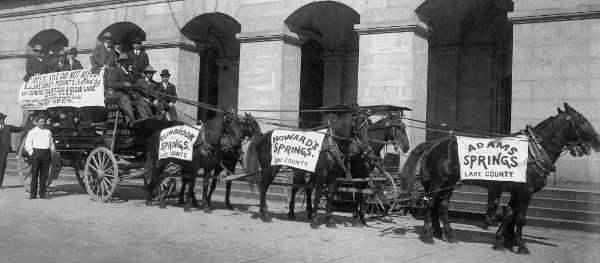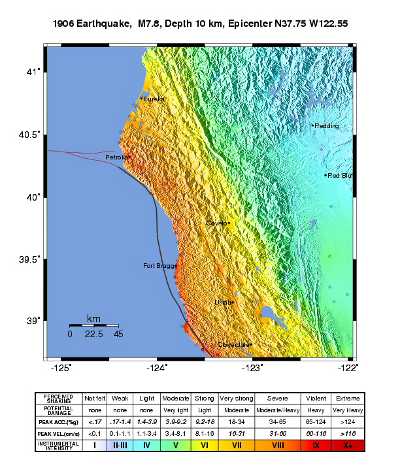LAKE COUNTY, Calif. – A recently released study on health factors in counties nationwide gave Lake County a low overall ranking, citing smoking, alcohol use and deaths in vehicle crashes as being among the area's challenges.
The County Health Rankings, released late last month by the University of Wisconsin Population Health Institute and the Robert Wood Johnson Foundation, assessed a number of factors in arriving at county-by-county health snapshots of the more than 3,000 counties in all 50 states.
“This report shows us that there are big differences in overall health across California’s counties, due to many factors, ranging from individual behavior to quality of health care, to education and jobs, to access to healthy foods, and to quality of the air,” says Patrick Remington, MD, MPH, associate dean for Public Health, University of Wisconsin School of Medicine and Public Health.
Out of 56 California counties examined in the report – Alpine and Sierra weren't ranked – Lake County ranked 53 in overall health outcomes, which researchers said was a slight improvement from 2010, when Lake County ranked 54.
“They don't intend for it to be a judgment about how good or bad we are,” said Lake County’s Health Officer Dr. Karen Tait. “It's really intended to point out where the significant areas are so we can look at ourselves and basically mobilize to try to address some of those issues.”
She said the report doesn't compare all counties against each other. “They rank them state by state.”
Tait said this is the second year for the report, which uses many of the same data sources as the 2010 Lake County Community Health Needs Assessment, which was completed last year.
As such, Tait said the two reports arrive at many of the same conclusions, and so she found the County Health Rankings didn't include any major surprises. “I think it just really, for me, validated what we saw in the health needs assessment,” and also helps give an idea of where the county needs to focus its efforts, she added.
The basis of the report was what organizers called “a standard formula to measure how long people live and how healthy they are.”
The report's key measures used to assess overall health levels – what the researchers termed “health outcomes” – were the rate of people prematurely dying before age 75, the percent of people who report being in fair or poor health, the numbers of days people report being in poor physical and poor mental health, and the rate of low-birthweight infants.
“The kind of unique thing about this is the way they weight some of the factors,” Tait said, and how the report makes certain judgments about what's important to health.
For premature death, or mortality, the county ranked No. 54, but did slightly better, ranking No. 43, for morbidity, the term for how people feel overall.
Also assessed were health behavior, clinical care, social and economic factors, and physical environment. Lake ranked 52 in health behavior, received a 31 in clinical care and a 46 in social factors, and had its best ranking, 26, in physical environment.
The report also looked at counties' rates of adult smoking, adult obesity, binge drinking and teenage pregnancy; the number of uninsured adults, availability of primary healthcare providers and preventable hospital stays; rates of high school graduation, number of children in poverty, rates of violent crime, access to healthy foods, air pollution levels and liquor store density.
Important factors cited by researchers in arriving at Lake County's health picture included its high rate of unemployment, at 19.5 percent in March, compared to the statewide rate of 12 percent.
In addition, 23 percent of the county's adults report being cigarette smokers, while 21 percent of adults report regular heavy alcohol use and/or binge drinking, the report found.
Those findings relating to smoking were similar to those reported in the 2010 Lake County Community Health Needs Assessment, which found that 25.9 percent of the county's adults reported being smokers, compared to 14.5 percent statewide.
The county's death rate associated with motor vehicle crashes was 28 out of 100,000, a rate that researchers said was twice California's rate.
That also is similar to findings in the health needs assessment which, based on the California Department of Public Health's County Health Status Profiles for 2010, reported that Lake County was ranked No. 52 statewide for deaths in motor vehicle crashes, with an age-adjusted death rate more than twice the state average and just under twice the national average.
Other factors causing a lower ranking for the county included findings of the availability of only one primary care healthcare provider for each 1,228 Lake County residents, compared to one for each 847 Californian statewide.
The report did note that that number was “slightly improved” compared to 2010 and Lake County fared as well or better than other Californians when it comes to preventable hospital stays, and for diabetes and mammography screenings.
How Lake compares with the region
Many of the state's rural counties ranked lower in the study, with Bay Area, coastal and some mid-state counties bordering on Nevada ranking higher.
Marin County had the best overall ranking statewide, and Trinity County the lowest, according to the report.
Lake's neighboring counties had, for the most part, better rankings: Colusa, 8; Yolo, 9; Sonoma, 12; Napa, 14; Glenn, 32; and Mendocino, 33.
The report also used a county health calculator, http://chc.humanneeds.vcu.edu/#106045/56/education , to look at peoples' level of education and income, and how those factors impact health.
That county health calculator put Lake County's percentage of adults with some college education at 51 percent, below the statewide average of 57 percent.
Sixty percent of the county's population has a “basic income” – at least twice the federal poverty level, which in 2009 for a family of four was $44,980. That's below the statewide average of 68 percent.
Tait pointed out that the report had limitations.
“Last year we did very well on the physical environment” because it was largely based on air quality, she said.
However, this year the report added a new category, access to recreational facilities, which caused the county's overall score in physical environment to drop. Tait said that's because that category considered things like athletic clubs and other more business-related facilities, rather than the lake and the outdoors.
“We were a little bit sensitive” about that finding, she said.
Tait said there were several areas of good news, including a slight improvement in preventable hospital stays, fewer children in poverty and a reduced teen birth rate.
“Any progress at all is good,” said Tait, noting, “I'm the perpetual optimist.”
Overall, Tait said there are many factors that affect lifestyle, which correlate to the state of the economy and the choices people are making.
“We know we just have a lot of challenges in that area,” she said.
One of the challenges is how to speak effectively to those health issues with the community, especially at a time when the economy is so difficult, said Tait, who suggested that community involvement is the most effective way to reach the larger population.
Putting out brochures, she said, doesn't always speak to everybody. “When you're dealing with behavioral issues it's complex,” she said.
If people are struggling with the economy and unemployment, it's very easy to tell them to stop smoking or drink less, “but it's not really realistic” because they're not in a place to feel motivated, Tait explained.
“I think we need to find some creative ways to motivate and influence healthful behaviors more effectively than we have,” she said.
Tait said several organizations and programs in Lake County are working to improve the county's health, and county health officials are partnering with those organizations.
Those organizations include the Health Leadership Network, which works on obesity prevention and promotes physical activity, and now is turning new attention to smoking-related issues, “because that's such a common thread with so many of these health conditions,” Tait said.
The Lake County/City Area Planning Council is studying transportation, as they're aware of the health effects of transit planning, and Tait said the Lake Family Resource Center has many programs that promote health, including smoking cessation and tobacco education.
The rankings, according to Risa Lavizzo-Mourey, M.D., president and chief executive officer of the Robert Wood Johnson Foundation, demonstrate that “health happens where we live, learn, work and play,” with many of those influences found outside the doctor's office.
Lavizzo-Mourey added, “We hope the County Health Rankings spur all sectors – government, business, community and faith-based groups, education and public health – to work together on solutions that address barriers to good health and help all Americans lead healthier lives.”
The rankings will be presented during a congressional briefing in Washington, DC, on Tuesday, April 19.
To see the full report visit www.countyhealthrankings.org.
E-mail Elizabeth Larson at This email address is being protected from spambots. You need JavaScript enabled to view it. . Follow Lake County News on Twitter at http://twitter.com/LakeCoNews , on Facebook at http://www.facebook.com/pages/Lake-County-News/143156775604?ref=mf and on YouTube at http://www.youtube.com/user/LakeCoNews .


 How to resolve AdBlock issue?
How to resolve AdBlock issue? 










 SACRAMENTO – Upon learning that millions of dollars in employee salary and travel advances are going uncollected, Governor Edmund G. Brown, Jr. on Tuesday issued an executive order to ensure state agencies and departments recover taxpayer dollars and improve internal accounting.
SACRAMENTO – Upon learning that millions of dollars in employee salary and travel advances are going uncollected, Governor Edmund G. Brown, Jr. on Tuesday issued an executive order to ensure state agencies and departments recover taxpayer dollars and improve internal accounting. 





